Surface-level Note
Issue Date: 2023-04-25 [Paper Note] Enhancing Chain-of-Thoughts Prompting with Iterative Bootstrapping in Large Language Models, Jiashuo Sun+, NAACL'24 Findings, 2023.04 GPT Summary- Iter-CoTは、LLMsの推論チェーンのエラーを修正し、正確で包括的な推論を実現するための反復的ブートストラッピングアプローチを提案。適度な難易度の質問を選択することで、一般化能力を向上させ、10のデータセットで競争力のある性能を達成。 Comment
Zero shot CoTからスタートし、正しく問題に回答できるようにreasoningを改善するようにpromptをreviseし続けるループを回す。最終的にループした結果を要約し、それらをプールする。テストセットに対しては、プールの中からNshotをサンプルしinferenceを行う。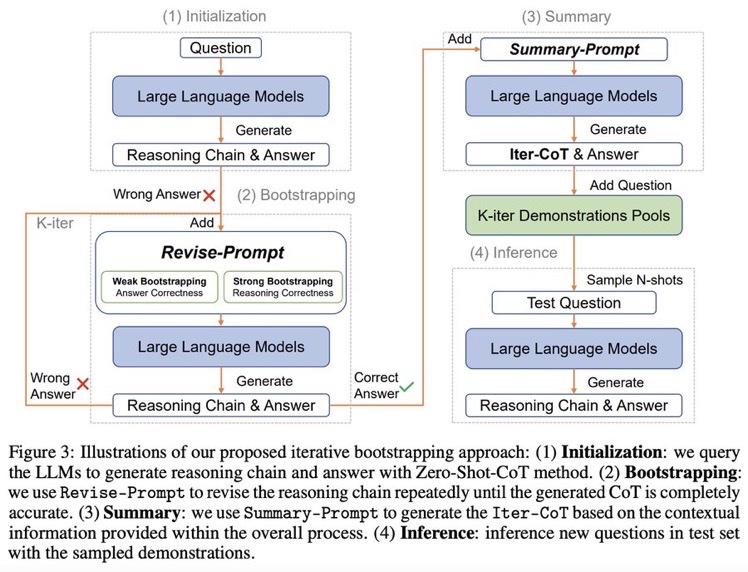
できそうだなーと思っていたけど、早くもやられてしまった
実装: https://github.com/GasolSun36/Iter-CoT
# モチベーション: 既存のCoT Promptingの問題点
## Inappropriate Examplars can Reduce Performance
まず、既存のCoT prompting手法は、sampling examplarがシンプル、あるいは極めて複雑な(hop-based criterionにおいて; タスクを解くために何ステップ必要かという情報; しばしば人手で付与されている?)サンプルをサンプリングしてしまう問題がある。シンプルすぎるサンプルを選択すると、既にLLMは適切にシンプルな回答には答えられるにもかかわらず、demonstrationが冗長で限定的になってしまう。加えて、極端に複雑なexampleをサンプリングすると、複雑なquestionに対しては性能が向上するが、シンプルな問題に対する正答率が下がってしまう。
続いて、demonstration中で誤ったreasoning chainを利用してしまうと、inference時にパフォーマンスが低下する問題がある。下図に示した通り、誤ったdemonstrationが増加するにつれて、最終的な予測性能が低下する傾向にある。
これら2つの課題は、現在のメインストリームな手法(questionを選択し、reasoning chainを生成する手法)に一般的に存在する。
- Automatic Chain of Thought Prompting in Large Language Models, Zhang+, Shanghai Jiao Tong University, ICLR'23
- Automatic prompt augmentation and selection with chain-of-thought from labeled data, Shum+, The Hong Kong University of Science and Technology, arXiv'23
のように推論時に適切なdemonstrationを選択するような取り組みは行われてきているが、test questionに対して推論するために、適切なexamplarsを選択するような方法は計算コストを増大させてしまう。
これら研究は誤ったrationaleを含むサンプルの利用を最小限に抑えて、その悪影響を防ぐことを目指している。
一方で、この研究では、誤ったrationaleを含むサンプルを活用して性能を向上させる。これは、たとえば学生が難解だが回答可能な問題に取り組むことによって、問題解決スキルを向上させる方法に類似している(すなわち、間違えた部分から学ぶ)。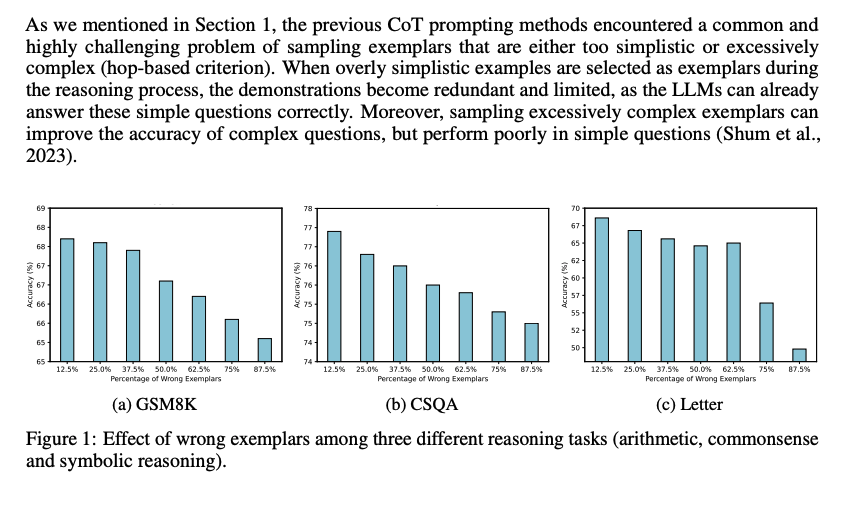
## Large Language Models can self-Correct with Bootstrapping
Zero-Shot CoTでreasoning chainを生成し、誤ったreasoning chainを生成したpromptを**LLMに推敲させ(self-correction)**正しい出力が得られるようにする。こういったプロセスを繰り返し、correct sampleを増やすことでどんどん性能が改善していった。これに基づいて、IterCoTを提案。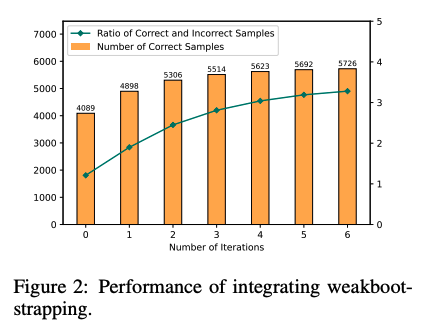
# IterCoT: Iterative Bootstrapping in Chain-of-Thought Prompting
IterCoTはweak bootstrappingとstrong bootstrappingによって構成される。
## Weak bootstrapping
- Initialization
- Training setに対してZero-shot CoTを実施し、reasoning chainとanswerを得
- Bootstrapping
- 回答が誤っていた各サンプルに対して、Revise-Promptを適用しLLMに誤りを指摘し、新しい回答を生成させる。
- 回答が正確になるまでこれを繰り返す。
- Summarization
- 正しい回答が得られたら、Summary-Promptを利用して、これまでの誤ったrationaleと、正解のrationaleを利用し、最終的なreasoning chain (Iter-CoT)を生成する。
- 全体のcontextual informationが加わることで、LLMにとって正確でわかりやすいreasoning chainを獲得する。
- Inference
- questionとIter-Cotを組み合わせ、demonstration poolに加える
- inference時はランダムにdemonstraction poolからサンプリングし、In context learningに利用し推論を行う
## Strong Bootstrapping
コンセプトはweak bootstrappingと一緒だが、Revise-Promptでより人間による介入を行う。具体的には、reasoning chainのどこが誤っているかを明示的に指摘し、LLMにreasoning chainをreviseさせる。
これは従来のLLMからの推論を必要としないannotationプロセスとは異なっている。何が違うかというと、人間によるannnotationをLLMの推論と統合することで、文脈情報としてreasoning chainを修正することができるようになる点で異なっている。
# 実験
Manual-CoT
- Chain of thought prompting elicits reasoning in large language models, Wei+, Google Research, NeurIPS'22
Random-CoT
- Chain of thought prompting elicits reasoning in large language models, Wei+, Google Research, NeurIPS'22
Auto-CoT
- Active prompting with chain-of-thought for large language models, Diao+, The Hong Kong University of Science and Technology, ACL'24
と比較。
Iter-CoTが11個のデータセット全てでoutperformした。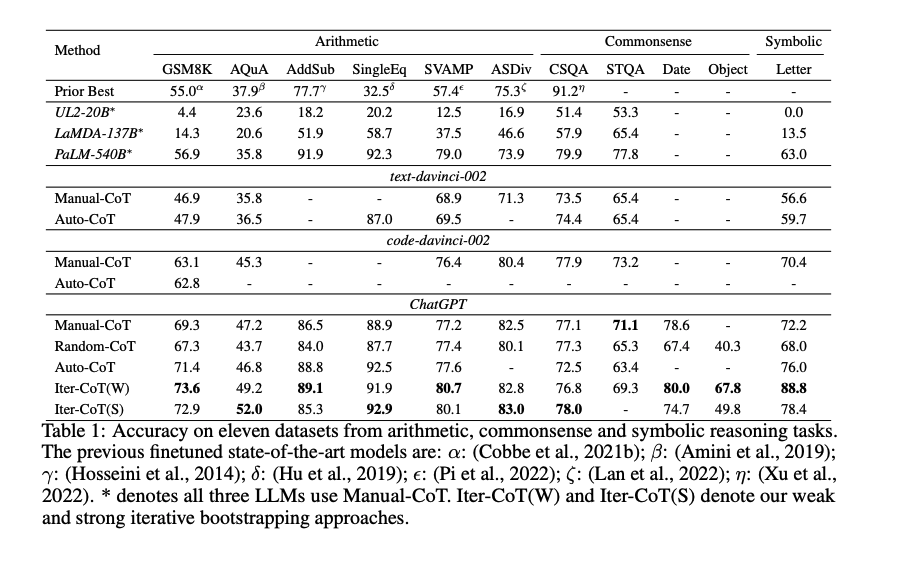
weak bootstrapingのiterationは4回くらいで頭打ちになった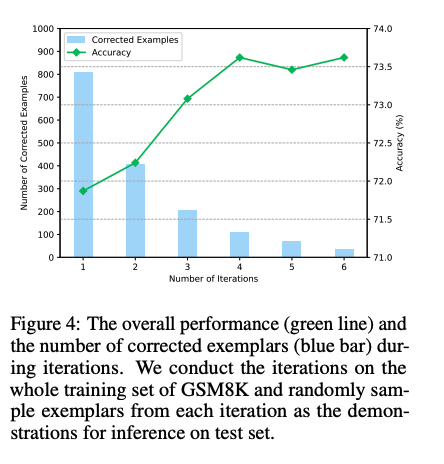
また、手動でreasoning chainを修正した結果と、contextにannotation情報を残し、最後にsummarizeする方法を比較した結果、後者の方が性能が高かった。このため、contextの情報を利用しsummarizeすることが効果的であることがわかる。
#PersonalizedDocumentSummarization #NLP #PersonalizedGeneration #Personalization #PersonalizedHeadlineGeneration #ACL
Issue Date: 2023-07-22 [Paper Note] Generating User-Engaging News Headlines, Cai+, ACL'23 GPT Summary- ニュース記事の見出しを個別化するために、ユーザープロファイリングを組み込んだ新しいフレームワークを提案。ユーザーの閲覧履歴に基づいて個別のシグネチャフレーズを割り当て、それを使用して見出しを個別化する。幅広い評価により、提案したフレームワークが多様な読者のニーズに応える個別の見出しを生成する効果を示した。 Comment
# モチベーション
推薦システムのヘッドラインは未だに全員に同じものが表示されており、ユーザが自身の興味とのつながりを正しく判定できるとは限らず、推薦システムの有用性を妨げるので、ユーザごとに異なるヘッドラインを生成する手法を提案した。ただし、クリックベイトは避けるようなヘッドラインを生成しなければならない。
# 手法
1. Signature Phrase Identification
2. User Signature Selection
3. Signature-Oriented Headline Generation
## Signature Phrase Identification
テキスト生成タスクに帰着させる。ニュース記事、あるいはヘッドラインをinputされたときに、セミコロン区切りのSignature Phraseを生成するモデルを用いる。今回は[KPTimes daasetでpretrainingされたBART](
https://huggingface.co/ankur310794/bart-base-keyphrase-generation-kpTimes)を用いた。KPTimesは、279kのニュース記事と、signature
phraseのペアが存在するデータであり、本タスクに最適とのこと。
## User Signature Selection
ターゲットドキュメントdのSignature Phrases Z_dが与えられたとき、ユーザのreading History H_uに基づいて、top-kのuser signature phrasesを選択する。H_uはユーザが読んだニュースのヘッドラインの集合で表現される。あるSignature Phrase z_i ∈ Z_dが与えられたとき、(1)H_uをconcatしたテキストをベクトル化したものと、z_iのベクトルの内積でスコアを計算、あるいは(2) 個別のヘッドラインt_jを別々にエンコーディングし、内積の値が最大のものをスコアとする手法の2種類のエンコーディング方法を用いて、in-batch contrastive learningを用いてモデルを訓練する。つまり、正しいSignature Phraseとは距離が近く、誤ったSignature Phraseとは距離が遠くなるように学習をする。
実際はユーザにとっての正解Signature Phraseは分からないが、今回は人工的に作成したユーザを用いるため、正解が分かる設定となっている。
## Signature-Oriented Headline Generation
ニュース記事d, user signature phrasesZ_d^uが与えられたとき、ヘッドラインを生成するモデルを訓練する。この時も、ユーザにとって正解のヘッドラインは分からないため、既存ニュースのヘッドラインが正解として用いられる。既存ニュースのヘッドラインが正解として用いられていても、そのヘッドラインがそのユーザにとっての正解となるように人工的にユーザが作成されているため、モデルの訓練ができる。モデルはBARTを用いた。
# Dataset
Newsroom, Gigawordコーパスを用いる。これらのコーパスに対して、それぞれ2種類のコーパスを作成する。
1つは、Synthesized User Datasetで、これはUse Signature Selection modelの訓練と評価に用いる。もう一つはheadline generationデータセットで、こちらはheadline generationモデルの訓練に利用する。
## Synthesized User Creation
実データがないので、実ユーザのreading historiesを模倣するように人工ユーザを作成する。具体的には、
1. すべてのニュース記事のSignature Phrasesを同定する
2. それぞれのSignature Phraseと、それを含むニュース記事をマッピングする
3. ランダムにphraseのサブセットをサンプリングし、そのサブセットをある人工ユーザが興味を持つエリアとする。
4. サブセット中のinterest phraseを含むニュース記事をランダムにサンプリングし、ユーザのreading historyとする
train, dev, testセット、それぞれに対して上記操作を実施しユーザを作成するが、train, devはContrastive Learningを実現するために、user signature phrases (interest phrases)は1つのみとした(Softmaxがそうなっていないと訓練できないので)。一方、testセットは1~5の範囲でuser signature phrasesを選択した。これにより、サンプリングされる記事が多様化され、ユーザのreadinig historyが多様化することになる。基本的には、ユーザが興味のあるトピックが少ない方が、よりタスクとしては簡単になることが期待される。また、ヘッドラインを生成するときは、ユーザのsignature phraseを含む記事をランダムに選び、ヘッドラインを背衛星することとした。これは、relevantな記事でないとヘッドラインがそもそも生成できないからである。
## Headline Generation
ニュース記事の全てのsignature phraseを抽出し、それがgivenな時に、元のニュース記事のヘッドラインが生成できるようなBARTを訓練した。ニュース記事のtokenは512でtruncateした。平均して、10個のsignature phraseがニュース記事ごとに選択されており、ヘッドライン生成の多様さがうかがえる。user signature phraseそのものを用いて訓練はしていないが、そもそもこのようにGenericなデータで訓練しても、何らかのphraseがgivenな時に、それにバイアスがかかったヘッドラインを生成することができるので、user signature phrase selectionによって得られたphraseを用いてヘッドラインを生成することができる。
# 評価
自動評価と人手評価をしている。
## 自動評価
人手評価はコストがかかり、特に開発フェーズにおいては自動評価ができることが非常に重要となる。本研究では自動評価し方法を提案している。Headline-User DPR + SBERT, REC Scoreは、User Adaptation Metricsであり、Headline-Article DPR + SBERT, FactCCはArticle Loyalty Metricsである。
### Relevance Metrics
PretrainedなDense Passage Retrieval (DPR)モデルと、SentenceBERTを用いて、headline-user間、headline-article間の類似度を測定する。前者はヘッドラインがどれだけユーザに適応しているが、後者はヘッドラインが元記事に対してどれだけ忠実か(クリックベイトを防ぐために)に用いられる。前者は、ヘッドラインとuser signaturesに対して類似度を計算し、後者はヘッドラインと記事全文に対して類似度を計算する。user signatures, 記事全文をどのようにエンコードしたかは記述されていない。
### Recommendation Score
ヘッドラインと、ユーザのreadinig historyが与えられたときに、ニュースを推薦するモデルを用いて、スコアを算出する。モデルとしては、MIND datsetを用いて学習したモデルを用いた。
### Factual Consistency
pretrainedなFactCCモデルを用いて、ヘッドラインとニュース記事間のfactual consisency score を算出する。
### Surface Overlap
オリジナルのヘッドラインと、生成されたヘッドラインのROUGE-L F1と、Extractive Coverage (ヘッドラインに含まれる単語のうち、ソースに含まれる単語の割合)を用いる。
### 評価結果
提案手法のうち、User Signature Selection modelをfinetuningしたものが最も性能が高かった。エンコード方法は、(2)のヒストリのタイトルとフレーズの最大スコアをとる方法が最も性能が高い。提案手法はUser Adaptationをしつつも、Article Loyaltyを保っている。このため、クリックベイトの防止につながる。また、Vanilla Humanは元記事のヘッドラインであり、Extracitve Coverageが低いため、より抽象的で、かつ元記事に対する忠実性が低いことがうかがえる。
## 人手評価
16人のevaluatorで評価。2260件のニュース記事を収集(113 topic)し、記事のヘッドラインと、対応するトピックを見せて、20個の興味に合致するヘッドラインを選択してもらった。これをユーザのinterest phraseとreading _historyとして扱う。そして、ユーザのinterest phraseを含むニュース記事のうち、12個をランダムに選択し、ヘッドラインを生成した。生成したヘッドラインに対して、
1. Vanilla Human
2. Vanilla System
3. SP random (ランダムにsignature phraseを選ぶ手法)
4. SP individual-N
5. SP individual-F (User Signature Phraseを選択するモデルをfinetuningしたもの)
の5種類を評価するよう依頼した。このとき、3つの観点から評価をした。
1, User adaptation
2. Headline appropriateness
3. Text Quality
結果は以下。
SP-individualがUser Adaptationで最も高い性能を獲得した。また、Vanilla Systemが最も高いHeadline appropriatenessを獲得した。しかしながら、後ほど分析した結果、Vanilla Systemでは、記事のメインポイントを押さえられていないような例があることが分かった(んーこれは正直他の手法でも同じだと思うから、ディフェンスとしては苦しいのでは)。
また、Vanilla Humanが最も高いスコアを獲得しなかった。これは、オーバーにレトリックを用いていたり、一般的な人にはわからないようなタイトルになっているものがあるからであると考えられる。
# Ablation Study
Signature Phrase selectionの性能を測定したところ以下の通りになり、finetuningした場合の性能が良かった。
Headline Generationの性能に影響を与える要素としては、
1. ユーザが興味のあるトピック数
2. User signature phrasesの数
がある。
ユーザのInterest Phrasesが増えていけばいくほど、User Adaptationスコアは減少するが、Article Loyaltyは維持されたままである。このため、興味があるトピックが多ければ多いほど生成が難しいことがわかる。また、複数のuser signature phraseを用いると、factual errorを起こすことが分かった(Billgates, Zuckerbergの例を参照)。これは、モデルが本来はirrelevantなフレーズを用いてcoherentなヘッドラインを生成しようとしてしまうためである。
※interest phrases => gold user signatures という理解でよさそう。
※signature phrasesを複数用いるとfactual errorを起こすため、今回はk=1で実験していると思われる
GPT3にもヘッドラインを生成させてみたが、提案手法の方が性能が良かった(自動評価で)。
なぜPENS dataset [Paper Note] PENS: A Dataset and Generic Framework for Personalized News Headline Generation, ACL'21
を利用しないで研究したのか?
#PersonalizedDocumentSummarization #NLP #Dataset #LanguageModel #PersonalizedGeneration #Personalization #PersonalizedHeadlineGeneration #ACL
Issue Date: 2023-05-31 [Paper Note] PENS: A Dataset and Generic Framework for Personalized News Headline Generation, ACL'21 GPT Summary- この論文では、ユーザーの興味とニュース本文に基づいて、ユーザー固有のタイトルを生成するパーソナライズされたニュース見出し生成の問題を解決するためのフレームワークを提案します。また、この問題のための大規模なデータセットであるPENSを公開し、ベンチマークスコアを示します。データセットはhttps://msnews.github.io/pens.htmlで入手可能です。 Comment
# 概要
ニュース記事に対するPersonalizedなHeadlineの正解データを生成。103名のvolunteerの最低でも50件のクリックログと、200件に対する正解タイトルを生成した。正解タイトルを生成する際は、各ドキュメントごとに4名異なるユーザが正解タイトルを生成するようにした。これらを、Microsoft Newsの大規模ユーザ行動ログデータと、ニュース記事本文、タイトル、impressionログと組み合わせてPENSデータを構成した。
# データセット生成手順
103名のenglish-native [speakerの学生に対して、1000件のニュースヘッドラインの中から最低50件興味のあるヘッドラインを選択してもらう。続いて、200件のニュース記事に対して、正解ヘッドラインを生成したもらうことでデータを生成した。正解ヘッドラインを生成する際は、同一のニュースに対して4人がヘッドラインを生成するように調整した。生成されたヘッドラインは専門家によってqualityをチェックされ、factual informationにエラーがあるものや、極端に長い・短いものなどは除外された。
# データセット統計量
# 手法概要
Transformer Encoder + Pointer GeneratorによってPersonalizedなヘッドラインを生成する。
Transformer Encoderでは、ニュースの本文情報をエンコードし、attention distributionを生成する。Decoder側では、User Embeddingを組み合わせて、テキストをPointer Generatorの枠組みでデコーディングしていき、ヘッドラインを生成する。
User Embeddingをどのようにinjectするかで、3種類の方法を提案しており、1つ目は、Decoderの初期状態に設定する方法、2つ目は、ニュース本文のattention distributionの計算に利用する方法、3つ目はデコーディング時に、ソースからvocabをコピーするか、生成するかを選択する際に利用する方法。1つ目は一番シンプルな方法、2つ目は、ユーザによって記事で着目する部分が違うからattention distributionも変えましょう、そしてこれを変えたらcontext vectorも変わるからデコーディング時の挙動も変わるよねというモチベーション、3つ目は、選択するvocabを嗜好に合わせて変えましょう、という方向性だと思われる。最終的に、2つ目の方法が最も性能が良いことが示された。
# 訓練手法
まずニュース記事推薦システムを訓練し、user embeddingを取得できるようにする。続いて、genericなheadline generationモデルを訓練する。最後に両者を組み合わせて、Reinforcement LearningでPersonalized Headeline Generationモデルを訓練する。Rewardとして、
1. Personalization: ヘッドラインとuser embeddingのdot productで報酬とする
2. Fluency: two-layer LSTMを訓練し、生成されたヘッドラインのprobabilityを推定することで報酬とする
3. Factual Consistency: 生成されたヘッドラインと本文の各文とのROUGEを測りtop-3 scoreの平均を報酬とする
とした。
1,2,3の平均を最終的なRewardとする。
# 実験結果
Genericな手法と比較して、全てPersonalizedな手法が良かった。また、手法としては②のattention distributionに対してuser informationを注入する方法が良かった。News Recommendationの性能が高いほど、生成されるヘッドラインの性能も良かった。
# Case Study
ある記事に対するヘッドラインの一覧。Pointer-Genでは、重要な情報が抜け落ちてしまっているが、提案手法では抜け落ちていない。これはRLの報酬のfluencyによるものだと考えられる。また、異なるユーザには異なるヘッドラインが生成されていることが分かる。
slide: https://www.slideshare.net/akihikowatanabe3110/sentence-compression-by-deletion-with-lstms
#Multi #DocumentSummarization #NLP #Dataset #QueryBiased #Extractive #ACL #Selected Papers/Blogs Issue Date: 2017-12-28 [Paper Note] Query-Chain Focused Summarization, Baumel+, ACL'14 Comment
(管理人が作成した過去の紹介資料)
[Query-Chain Focused Summarization.pdf](https://github.com/AkihikoWatanabe/paper_notes/files/1590916/Query-Chain.Focused.Summarization.pdf)
上記スライドは私が当時作成した論文紹介スライドです。スライド中のスクショは説明のために論文中のものを引用しています。
